Keywords: #ProcessImprovement #Bottleneck #HowTo #ProcessMining #QueueingTheory #LittlesLaw
Bottlenecks are choke points or concentrated area which are either taking a long time to run, or so heavily utilized such that the process is taking longer than expected to run. As you can imagine, it creates such negative user connotation on user experience, it is always one of the first improvement goals.
Identifying and resolving bottleneck is a very effective way to improve process. In this article, we will learn how to spot potential bottlenecks in processes like a champion!
Before You Begin…
Option 1. Quick Setup
We will use this Power BI Template to describe the steps in this article. You will need Power BI Desktop to use this template.
Option 2. Manual Setup
- Have a Microsoft PowerBI account and Power BI Desktop
- Setup ProcessChampion (Free Edition) or alternatively, use this Power BI Template to follow the contents in this article.
- Use this Sample Data (376Kb).
Let’s go!
Initial Load
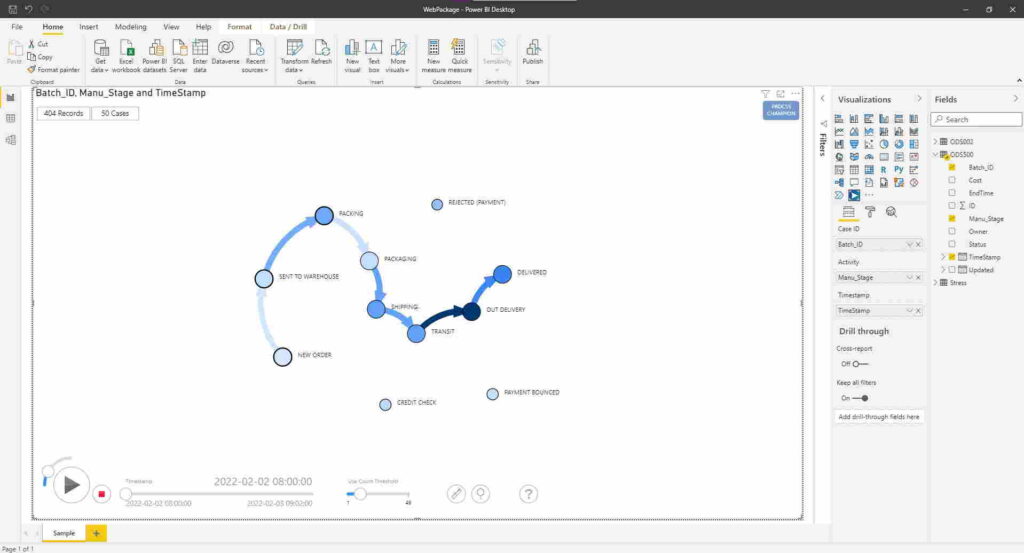
Congratulations! You are ready to go!
Layout
Let’s get familiar with the layout of ProcessChampion on Power BI
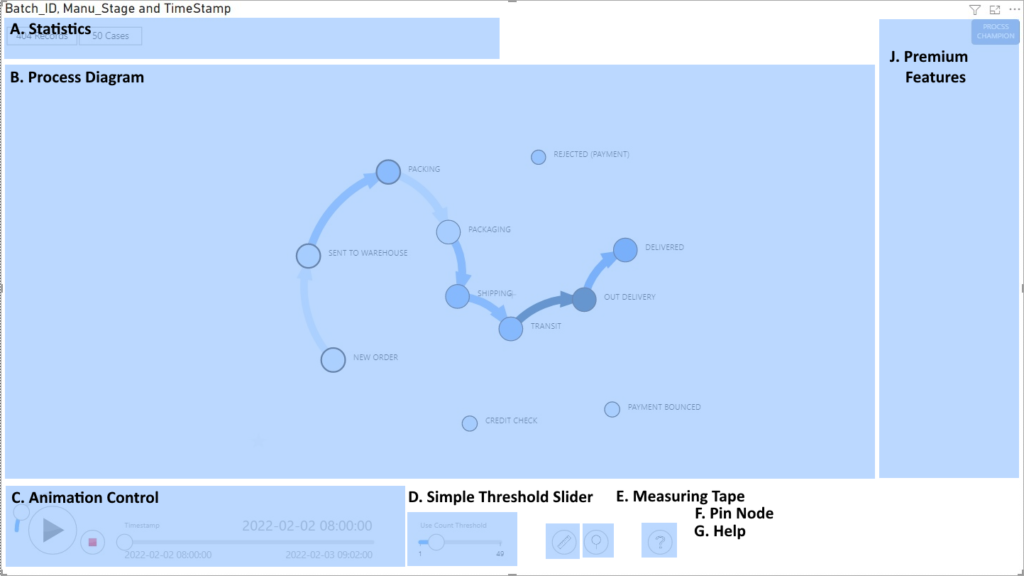
ProcessChampion has multiple regions on the user interface where you can interact and analyse. The regions include
A. Statistics – Shows the statistics of the Event Log file, including total records count and number of unique cases.
B. Process Diagram – The automatically discovered process map is shown here. The Circle (nodes) describe the Activities and the Lines (edge, or links) describe that there is at least one pair of events where a Case goes from Activity from to Activity to.
C. Animation Control – This is your main control for data animation, including Speed Control, Play/Pause, Stop and Timestamp
D. Simple Threshold Slider – This slider controls the Use Count Threshold. It visually connects or disconnects the links (Lines on Process Diagram) between activities (circles on Process Diagram). Basically, it looks at how many times a link is used, and used the slider to show or hide (lesser used links). This is great for finding activity relationships which are more used than others.
E. Measuring Tape (On/Off, Shortcut Key CTRL) – This allows you to measure average time and utilization across ANY two activities (nodes).
F. Pin Node (On/Off, Shortcut Key SHIFT) – This allows you to move and hold the Nodes in place. This is useful when you want to move the activities around for different views.
G. Help – Goes to the User Guide
J. Premium Features – This contains the menu when Premium features are activated. For this article, we can do everything with the free edition.
Reading Process Diagram
The main visual on ProcessChampion is the Process Diagram. You can see it uses two major graphical notations:
- A circle ◯ known as a node, which describes an activity . It is accompanied by a text label.
- An arrow link → (line between two circle) known as an edge, which describe the relationship between two activities. Note: The direction of the arrow is important, symbolizing a From/To relationship.

The process diagram is automatically discovered (or mined ⛏️) using the event logs.
Activities (Circle, Nodes)
Activities are illustrated by the circles in the diagram. Using our sample data, we can see that there are a total of 11 unique activities.
- NEW ORDER
- SENT TO WAREHOUSE
- PACKING
- PACKAGING
- SHIPPING
- TRANSIT
- OUT DELIVERY
- DELIVERED
- REJECTED (PAYMENT)
- CREDIT CHECK
- PAYMENT BOUNCED
The total number of circles describing activities are mined directly from the event log. All activities are shown.
Note: For performance and analytical reasons, you may want to introduce a soft cap to the number of unique activities to about 50.
Links (Edge, Arrow)
A link between two activities (e.g. NEW ORDER -> SENT TO WAREHOUSE) describe that there exist at least one occurrence where a case (Entity) goes from activity from, to activity to. The direction of the arrow is important.
Reading Use Count Threshold
Use Count Threshold and Floating Activities
You may notice some floating activities? For example, the activities REJECTED (PAYMENT), CREDIT CHECK and PAYMENT BOUNCED are not joined to any other activities. You might be wondering why?
The floating activities are the result of the Threshold. This is a number which which hides links if the link’s use count fall under this threshold. For example, if the threshold is 20, then any link that is used less than 20 times is not shown.
Why is this important? Adjusting this threshold allows you to view a simplified version of the process.
Note: This is only implying less used links may be less important and not a concrete definition. You as the subject matter expert will be able to make this call.
The threshold is controlled by the Threshold Slider. Try sliding the Use Count Threshold slider to the far left.

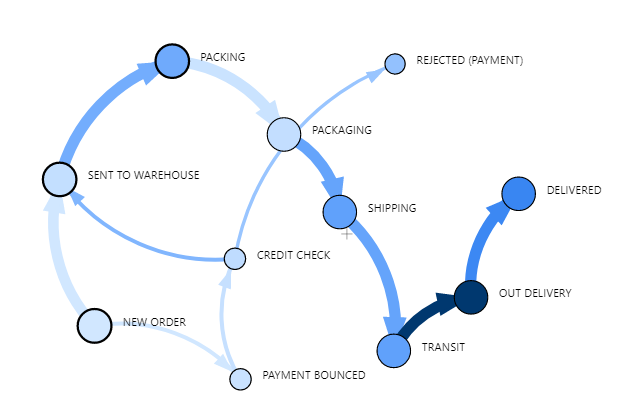
With a very low threshold (sliding to the left), you can see that all the floating activities are now connected to others. Conversely, if you slide the slider to the right, you are imposing a higher threshold which is a stricter rule in terms of what links to show.

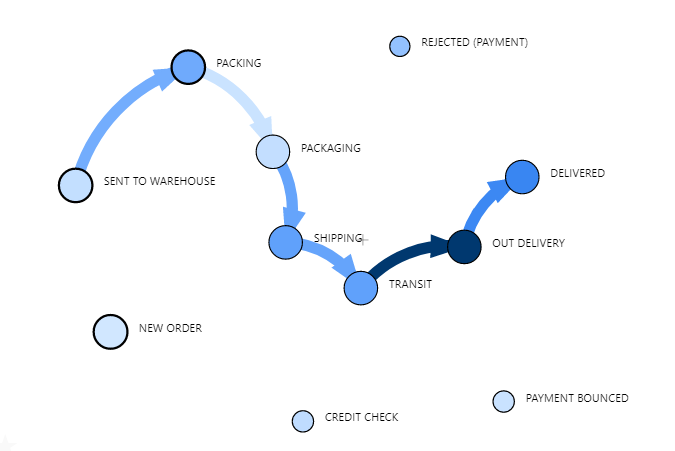
In a ideal world, every event happens according to the process definition. However, in the real world, there will be exceptions, deviations and variants of the same process. This is really useful for removing noise which can be very common in event logs. You can use this slider to investigate an optimum set of events, or sometimes derive a simpler process by omitting less used activities.
Reading Color Codes
ProcessChampion uses a shade of Color Codes to represent Average Duration. The following shade of Blue goes from lightest to the darkest, representing shortest average duration to the longest average duration.

The color codes are relative to the values in the event log. They are applied to BOTH Activities (Nodes) and Links (Edges).
Analysis
At a glance, you can already tell that the activity OUT DELIVERY is taking the longest (darkest blue) among the activities. Conversely, activities like NEW ORDER and PACKAGING are shortest.
The same rules apply to links. For example, the link TRANSIT -> OUT DELIVERY is taking the longest (darkest blue) among the links and PACKING -> PACKAGING is the shortest
If you are identifying potential bottlenecks, this will be a great place to take a deep dive and work on.
Reading Object Sizes
ProcessChampion uses different sizes to describe use count. Similar to color codes, this applies to both links and circles. i.e. The bigger the circle, the more utilized an activity is. For the links, it is applied to the thickness of the link.

Try making your own observation on which activity and links are used the most?
Analysis
Activities: Visually, 8 of the 11 activities: NEW ORDER, SENT TO WAREHOUSE, PACKING, PACKAGING, SHIPPING, TRANSIT, OUT DELIVERY and DELIVERED are used a lot and about the same (large circle), while the remaining 3 are less used (smaller circle).
Links: Visually, the following links are more used than others.
- NEW ORDER -> SENT TO WAREHOUSE
- SENT TO WAREHOUSE -> PACKING
- PACKING -> PACKAGING
- PACKAGING -> SHIPPING
- SHIPPING -> TRANSIT
- TRANSIT -> OUT DELIVERY
- OUT DELIVERY -> DELIVERED
4 other links (with thinner links) are used less. Can you spot them?
Show More Information
ProcessChampion comes with a lot of configurations that can be added on the visual. I refer to the Power BI’s configuration pane. Open the configuration settings. We will focus on the first 4.
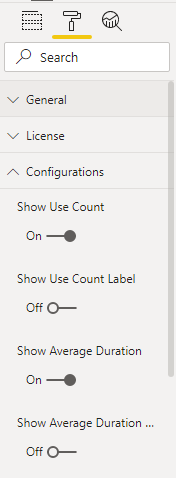
- Show Use Count (Default: On) – This switches on/off the use of size as use count
- Show Use Count Label (Default: Off) – This switches on/off a label which shows use count
- Show Average Duration (Default: On) – This switches on/off the use of color as average duration
- Show Average Duration Label (Default: Off) – this switches on/off a label which shows average duration.
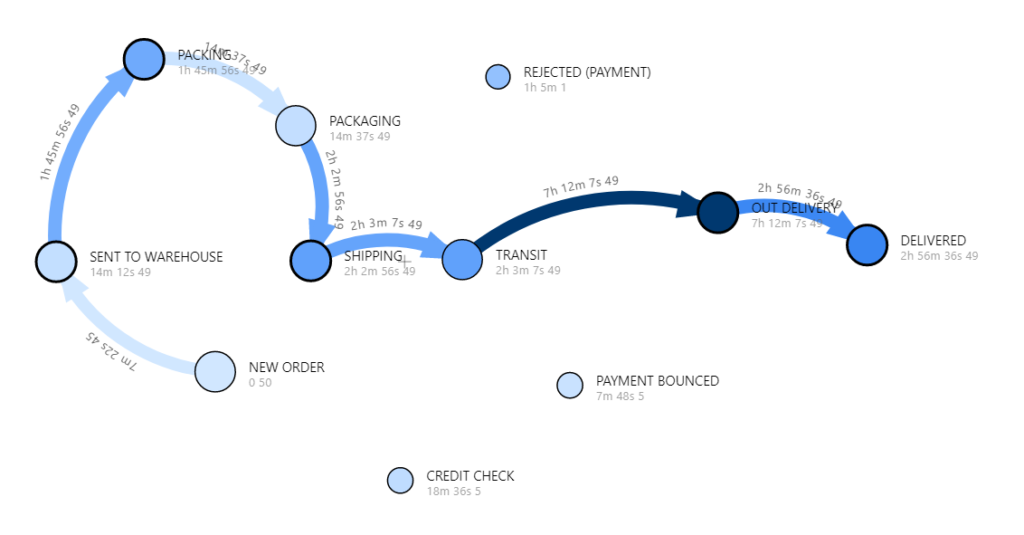
These give you more indication and information for analysis. Both Use Count and Average Duration are presented. You can further validate the bottlenecks you have identified.
Using Measuring Tape
By now you would have some conclusions and impressions on where and what to look. To further enhance your findings you can use the measuring tape feature.

Click on the measuring tape icon (on the bottom of the visual) to activate it. To use the measuring tape.
- Step 1. Click (press and release) on an activity, e.g. NEW ORDER. Remember to release the button.
- Step 2. Click on another activity, e.g. TRANSIT.
- View the results of the measuring tape. It says “6h23m3s 49”

The results of this measurment means that the events from NEW ORDER to TRANSIT takes an average of 6 hours, 23 minute and 3 seconds and it has been used 49 times.
Try it on other pairs. If there is no relationship between any two activities, the measuring tape will show “No Path“. Now try it on other activity pairs.
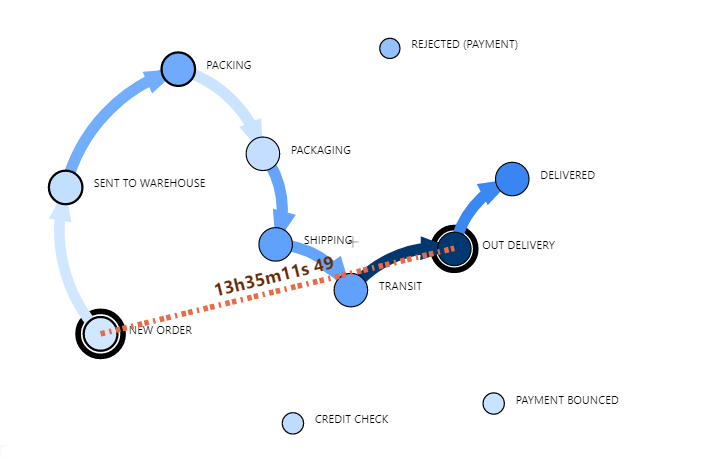
NEW ORDER -> OUT DELIVERY (Average 13 Hours, 35 Minute and 11 Second, 49 times)

TRANSIT -> OUT DELIVERY (7 hours, 12 Minute and 7 Second, 49 times).
You can use the measuring tape to measure activities which are not linked directly and get a good sense of average duration across the entire process.
Conclusion
Well done! You have successfully used Power BI and ProcessChampion to identify potential process bottlenecks.
It is pretty straight forward isn’t it? f you think that the activity OUT DELIVERY may potentially be the bottleneck, I think you are spot on. The data set is a mock up of real world operations. It is typical of an online shopping process and tracking where the delivery stage takes the longest. To reduce this bottleneck, major online shopping portals setup distribution and logistical warehouse in major cities to deliver their goods within hours, a great improvement in user experience don’t you think?
A few things to note:
Choosing the next best spot to improve
Some times the most utilized activity cannot be improved. This can be due to controls not within your reach, or the activity is fixated and cannot be changed. In such case, continue to traverse the rest of the activities and links to find the next best spot/activity to improve.
Shifting Bottlenecks
Another common phenomenon is the shifting bottleneck issue. When one area is improved, the bottleneck may shift to another part of the process. This is fairly common in process improvement. Simple repeat the analysis using new data for validation and ongoing improvement.
Prolonging activities
While not as common, you may have to extend the duration of the average process instead of shortening it. In this case, you may start by investigating the activity which runs the shortest (light blue). However, I find it easier and have more success by extending the duration of a long activity even longer.
Next Steps
Well done!
- Try it with your own Event Logs. If you have trouble getting event logs, read our blog on event logs and where to find them.
- Further reading: Streamline your process, set and align your process to improvement goals.
- Further questions? Contact our consulting team at support (at) argentlogic.com
